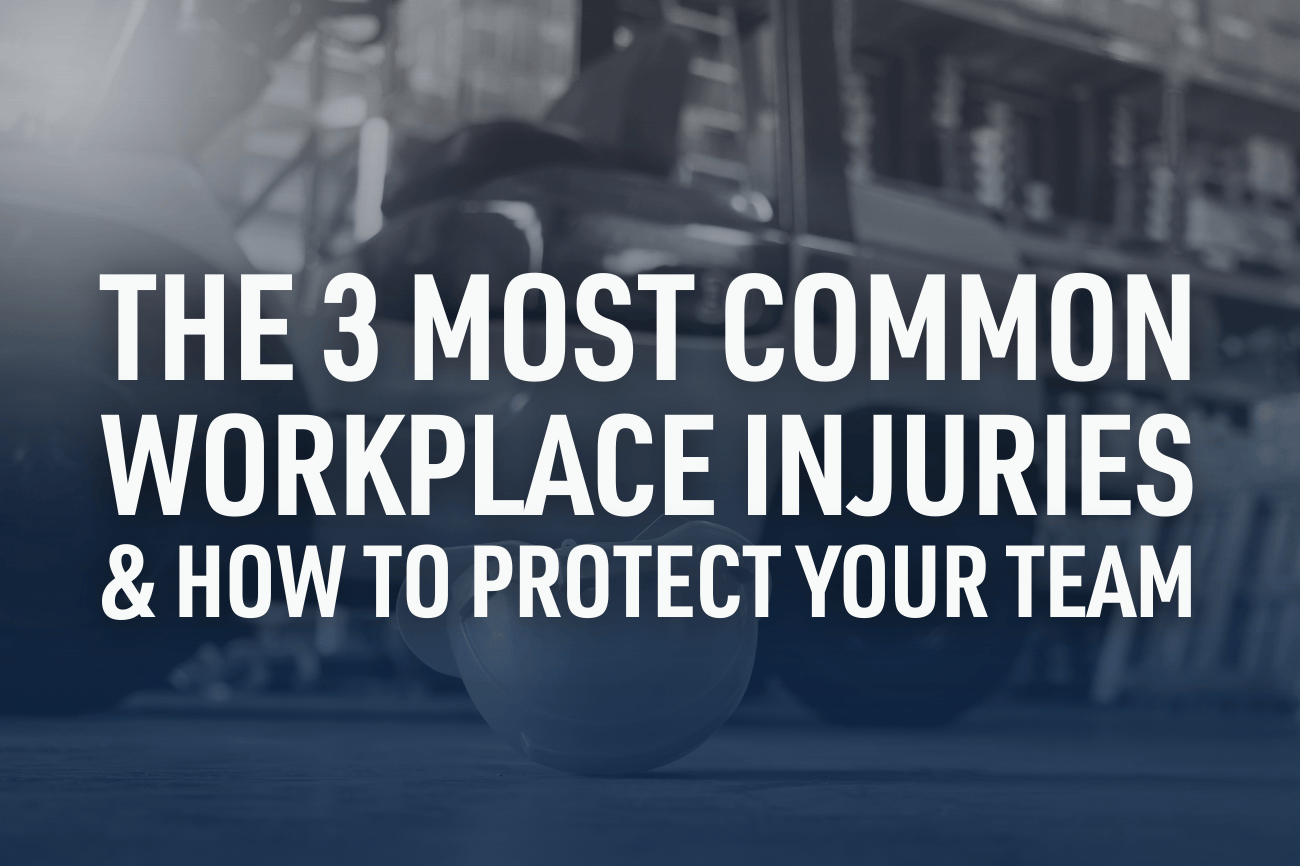4 min read
The 3 Most Common Workplace Injuries & How To Protect Your Team
John Wofford
Jun 13, 2025 8:01:19 AM

Three general injury types account for 71% of all U.S. workplace injuries.
That’s over 1.6 million injuries each year. Most of them are entirely preventable, meaning your organization is needlessly at risk. What would you do if you could protect your staff and company from 70% of workplace accidents?
Read on to learn the three most common workplace injuries and how to protect your team.
3. Slips, Trips, & Falls
Slips, trips, and falls account for approximately 20% of all workplace accidents.
Warehouse and transportation workers are especially susceptible to this hazard. In fact, 22.6 per 10,000 full-time workers will suffer a slip, trip, or falling injury, resulting in an average of 14 days of lost work. Yet these accidents are highly preventable.
There are three primary habits that you can adopt to prevent these injuries on the job site.
Good Housekeeping
Poor housekeeping is the most common cause of a slip or trip at work.
Unused pallets, discarded packing material, chemical spills, or any untidiness increase the odds of an accident. These are all avoidable. Encourage your workers to keep clean workspaces, picking up as they go to ensure there is never unsafe clutter.
Good housekeeping forms your first line of defense against slips and trips.
Fall Protection
Fall protection is so commonly overlooked that it made the top ten list of OSHA violations twice in 2024.
The first and most common violation is the absence of fall protection equipment. Fall protection can take many forms, from personal harnesses to railings and nets. The loading dock is one of the most common areas in a warehouse to fall in. Loading dock gates help prevent this by providing a physical barrier between workers and the ledge.
Invest in fall protection for your workers, whether they work on the warehouse floor or at height.
Cellphone Safety
In a warehouse, your smartphone can be dangerous.
Distraction is often the cause of a slip, trip, or fall. Cellphone use while walking—both calls and texting—is one of the leading distractions. Help protect your workforce by adopting a no-walking policy while on the phone.
This simple rule can spare your staff a serious accident.
2. Lifting Injuries & Overexertion
Half of all workers in the U.S. will suffer a lower back injury linked to lifting or overexertion at some point in their lives, making it the biggest cause of workplace injuries.
Lifting injuries are among the easiest to prevent. Yet, because lifting is so commonplace, workers often either ignore or are ignorant of the danger lifting can pose. In fact, lifting any item of any weight can lead to lower back injuries if done improperly.
Whether you think you’re at risk of a lifting injury or not, you are.
Can You Lift It?
Proper lifting technique is a decision tree.
First, determine if you can actually lift the object in question. This isn't a simple yes or no. Instead, it's an analysis of five key questions:
- Can you move the object without assistance?
- How high do you need to lift the object?
- How far do you have to carry the object?
- Will you have to repeat this task?
- Is the decision to lift without assistance more about ego or laziness than safety?
Be honest with yourself about the answers to these questions, as your back health could depend on it.
Proper Lifting Techniques
If you lift an object without support, your risk of injury increases if the item exceeds 25 lbs.
To help prevent injury, follow these simple steps to perform a safer lift:
- Feet. Plant one foot beside the object and one foot behind it.
- Knees. Bend with your knees and keep your back straight with your neck and head upright.
- Hands. Use your whole hand—not just fingers—to grasp the object.
- Pull. Pull the object close to your body, keeping your arms tucked to your sides.
- Lift. To lift the object, thrust your hips forward, keeping your core tight. Focus on using your leg muscles for lifting power.
- Move. To turn, keep your feet beneath you with your weight centered. Move slowly and carefully.
Following these steps won't eliminate the risk of injury, but it reduces your chances of lower back strain.
Injury Prevention
Before lifting, there are two actions you can take to help prevent an injury.
The first is to stay in shape. Physical fitness conditions the body to exertion and lifting. A regular fitness program builds strength and flexibility, reducing the rate of lifting and overexertion injuries.
However, the best practice is to use lifting equipment.
Hoists and dollies use mechanical energy to multiply lifting power. This reduces the strain on your body. Consequently, you can lift heavier objects with less risk.
As a warehouse manager, it’s your responsibility to ensure your team knows how to prevent these common injuries.
1. Exposure To Harmful Substances or Environments
Ever wonder why bomb squads blow up defused bombs?
It's because, even though they aren't active, they're still bombs and still dangerous. The same is true of your forklift. Just because it's off doesn't mean it isn't hazardous.
Forklift fuel is a powerful energy source.
If the fuel is still connected to the forklift, there's still the potential for serious injury. Yet, many operations don't think about that. Instead, they assume that the fork truck can't be a danger to anyone if the keys are locked up.
Unfortunately, they’re dead wrong.
Lockout/Tagout Procedures
Following proper lockout and tagout procedures is the best way to protect everyone on the team.
A proper lockout is more than locking up the key. The complete standard is defined by OSHA 1910.147 and 1910.33. However, it follows these basic steps:
- Alert all team members that the equipment is inoperable.
- Shut down the forklift or machine according to procedure.
- Disconnect any fuel or energy source.
- Isolate the energy source using the lockout box and attach the informational tag.
- Discharge any residual energy according to established safety procedures.
- Ensure the machine or forklift won’t start.
- Keep the equipment tagged out until a certified technician deems it safe.
Investing in a simple lockout box and tags by-the-roll is an easy and effective way to protect your team. These elementary tools help isolate dangerous power sources and warn workers about the hazards.
Energy discharge injuries are almost 100% avoidable with proper procedures. When these procedures aren’t used, workers can be seriously injured. On average, energy discharge injuries result in 13 days of missed work and associated worker’s compensation claims.
Proper lockout/tagout procedures are vital for protecting your team from harmful exposure injuries.
Your Accident Prevention Partner
Accidents happen, but they could happen a lot less often.
The Lilly Company is here to help. With over 100 years of industrial experience, we have the knowledge you need to make your operation the safest it can be. What could you achieve with an accident-free year?
To learn more about how to eliminate the most common workplace injuries, contact us online or visit one of our locations:
Arkansas - Jonesboro
Alabama - Birmingham, Dothan, Irondale, Madison, Mobile, and Montgomery
Mississippi - Belden, Tupelo, and Richland
Tennessee - Jackson, Memphis, Knoxville, and Kingsport
Further Reading
5 Forklift Safety Issues with Simple Solutions
Warehouse Safety Topics: Corrosive Materials
7 Easy Ergonomic Fixes to Make Employees More Productive
Posts by Tag
- Forklift (67)
- Forklift Service (19)
- Electric Forklifts (17)
- Forklift Safety (15)
- Warehouse Automation (13)
- Forklift Attachments (12)
- Product Review (12)
- Toyota Forklifts (12)
- Parts (10)
- Warehouse Planning (10)
- Clark Forklifts (8)
- Pallet Racking (8)
- Loading Docks (7)
- Material Handling Education (7)
- Purchasing Options (7)
- Aerial Equipment (6)
- Customer Solutions (6)
- Forklift Batteries (6)
- Forklift Rental (6)
- Forklift Tires (5)
- Heavy Equipment (5)
- Forklift Accessories (4)
- Forklift Fleet Management (4)
- Forklift Training (4)
- Pallet Jacks (4)
- Products (4)
- Utility Vehicles (4)
- Yard Spotter Trucks (4)
- Komatsu (3)
- Linde (3)
- Specialty Forklifts (3)
- Used Equipment (3)
- Warehouse Doors (3)
- IC Forklifts (2)
- Manitou (2)
- COMBiLift (1)
- Custom Shop (1)
- Forklift Brakes (1)
- Forklift Warranty (1)
- Gehl (1)
- Recruitment (1)








